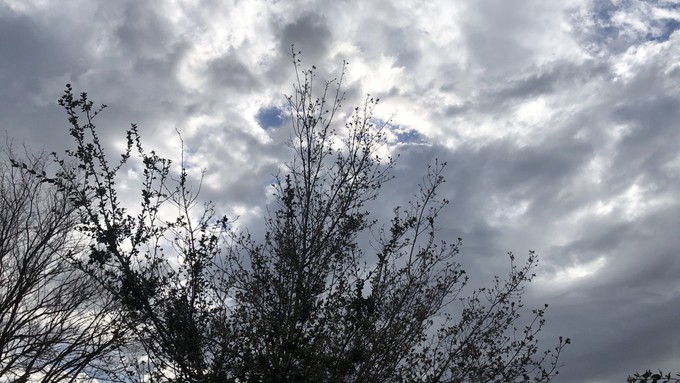
Be prepared; forecast calls for freezing temperatures and strong winds

So much for our sunny skies! Grey clouds and gusty winds have returned. Near-freezing temperatures, too. Kathy Morrison
Sacramento is about to get a double-dose of wintry weather: Intense cold and strong wind.
According to the National Weather Service, a storm front will create hazardous conditions Wednesday through Friday – including rare snowfall in the Sacramento Valley.
“Heavy low elevation snow with dangerous travel impacts expected tomorrow through Friday,” the Sacramento NWS tweeted Tuesday morning (Feb. 21). “Snow levels will fall to 1,000-2,000 feet tomorrow, with snow levels down to about 500 feet to the northern Sacramento Valley floor early Thursday morning and Thursday night to early Friday.”
Yes, snow is possible on the floor of the northern Sacramento Valley – and closer to home. Auburn, at 1,227 feet elevation and Placerville (elevation 1,867), definitely fall within the potential snow zone. But there’s a slight possibility flakes will fall as low as Roseville (elevation 164).
It’s not just the cold but the wind.
“Gusty winds will increase this afternoon over interior Northern California, slowly decreasing overnight,” the Sacramento NWS tweeted Tuesday. “Expect gusts 30 to 45 mph in the Valley and foothills and 40 to 70 mph over the mountains. Downed trees and branches, local power outages and difficult driving conditions are possible.”
In addition, overnight frost warnings are in the forecast Tuesday through Friday. Daytime highs will drop 20 degrees; the expected high on Thursday and Friday in Sacramento is only 48 degrees.
After several days of sunny, springlike weather, this downturn will be a shock to our plants, most of which already are in high-growth mode. Blooming fruit trees likely will lose their blossoms and may not set fruit. Expect to see some dieback on sprouting shrubs (such as roses). Newly transplanted vegetables or sprouting seeds are in danger of damping off.
What’s a gardener to do? Hold off on planting anything more until after this cold spree. Protect tender seedlings with row covers, milk cartons, water jugs or other shelter. Deep-water shrubs, trees and perennials; moist soil radiates heat and can raise the soil temperature (and surrounding space) just enough to prevent frost damage.
For more on freezing and frost, check out these recommendations from the UC Cooperative Extension master gardeners: https://ipm.ucanr.edu/PMG/GARDEN/ENVIRON/frostdamage.html.
Comments
0 comments have been posted.Sacramento Digs Gardening to your inbox.
Sites We Like
Garden Checklist for week of April 14
It's still not warm enough to transplant tomatoes directly in the ground, but we’re getting there.
* April is the last chance to plant citrus trees such as dwarf orange, lemon and kumquat. These trees also look good in landscaping and provide fresh fruit in winter.
* Smell orange blossoms? Feed citrus trees with a low dose of balanced fertilizer (such as 10-10-10) during bloom to help set fruit. Keep an eye out for ants.
* Apply slow-release fertilizer to the lawn.
* Thoroughly clean debris from the bottom of outdoor ponds or fountains.
* Spring brings a flush of rapid growth, and that means your garden needs nutrients. Fertilize shrubs and trees with a slow-release fertilizer. Or mulch with a 1-inch layer of compost.
* Azaleas and camellias looking a little yellow? If leaves are turning yellow between the veins, give them a boost with chelated iron.
* Trim dead flowers but not leaves from spring-flowering bulbs such as daffodils and tulips. Those leaves gather energy to create next year's flowers. Also, give the bulbs a fertilizer boost after bloom.
* Pinch chrysanthemums back to 12 inches for fall flowers. Cut old stems to the ground.
* Mulch around plants to conserve moisture and control weeds.
* From seed, plant beans, beets, cantaloupes, carrots, corn, cucumbers, melons, radishes and squash.
* Plant onion sets.
* In the flower garden, plant seeds for asters, cosmos, celosia, marigolds, salvia, sunflowers and zinnias.
* Transplant petunias, zinnias, geraniums and other summer bloomers.
* Plant perennials and dahlia tubers for summer bloom.
* Mid to late April is about the last chance to plant summer bulbs, such as gladiolus and tuberous begonias.
* Transplant lettuce seedlings. Choose varieties that mature quickly such as loose leaf.